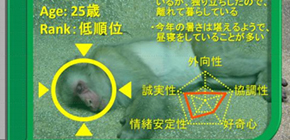
Observing monkey behavior from the primatologist’s perspective
Researchers develop an automatic detection and tracking system for wild Japanese monkeys using artificial intelligence
A team of researchers from Osaka University and Gifu University developed a system to detect and track wild Japanese monkeys in video recordings through a process of machine learning.
In primates, including humans, individuals with various personalities spend their lives in social groups. Conventionally, primatologists collected research data by distinguishing and tracking individual monkeys.
In recent years, automated observation systems for animals using artificial intelligence (AI), including machine learning, have advanced. In conventional methods, accuracy of detection and tracking of free-ranging animals in the wild becomes low because the intensity of natural lighting changes and animals hide behind others. For this reason, automatic detection and tracking systems that can work in various circumstances have been sought after.
In this study, the team used deep learning and a particle filter algorithm to develop AI for detection and tracking of free-ranging Japanese monkeys. Deep learning, a subset of machine learning in AI, has drawn attention in recent years as a means of image recognition because of its high identification accuracy.
The particle filter considers information from previous frames and uses it to locate the target in the current frame. It quickly recovers from temporary disappearance of the target in cases such as occlusion.
By combining these two techniques, the team examined tracking accuracy by using 30 video recordings, succeeding in tracking wild Japanese monkeys with higher accuracy than conventional methods. Since this automatic detection and tracking system also showed good results in identification of boars, bears, and deer, it was shown to have applications in the tracking of animals other than Japanese monkeys.
A combination of these results with individual recognition systems makes it possible to detect and track Japanese monkeys and, moreover, to identify them using AI. Currently, this team is developing “monkey glasses” that allows even beginners with no expertise to observe monkeys from the perspective of a primatologist. The glasses will help people learn the personality of individual monkeys in monkey parks and zoos and discover their appeal. Using the system they developed, the team is also advancing the development of a device to find wild animals using security cameras and inform local people in order to keep them safe.
Figure 1 . The red square represents that the monkey is being tracked.
Figure 2. “Monkey Glasses (image)” for displaying information about tracked monkeys
Figure 3. Automatic detection and tracking system: when wild animals, such as deer, boars, bears, and deer, are detected, information about the species and location of detected animals is sent to local residents via smartphone, serving as a warning system. This system to prevent crop damage and direct impact on local people is under development.
Left: Automatic detection and alert system (image)
Right: Field testing of the system
The Article, “Automatically detecting and tracking free-ranging Japanese macaques in video recordings with deep learning and particle filter” was published in Ethology at DOI: https://doi.org/10.1111/eth.12851 .
Related links
